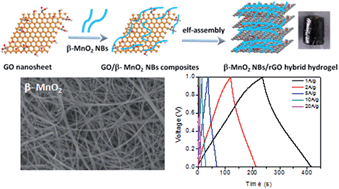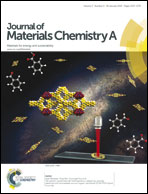Self-assembled three-dimensional hierarchical graphene hybrid hydrogels with ultrathin β-MnO2 nanobelts for high performance supercapacitors†
Abstract
We report a facile method to assemble a hierarchical and interconnected reduced graphene oxide/β-MnO2 (rGO/β-MnO2) nanobelt hybrid hydrogel by dispersion of presynthesized ultrathin β-MnO2 nanobelts (NBs) in graphene oxide (GO) precursor solution by a hydrothermal reaction. The microscopic structure of the three-dimensional (3D) hybrid hydrogel can be controlled by adjusting the content of the ultrathin β-MnO2 NBs, which exhibits the properties of low density, large specific surface area, and high compressive strength for the corresponding aerogel. Importantly, a typical hybrid hydrogel with 54.2% ultrathin β-MnO2 NBs displays a specific capacitance as high as 362 F g−1 at a current density of 1.0 A g−1, and even 282 F g−1 at 20 A g−1, which is three times higher than that of the pure rGO hydrogel (118 F g−1). Meanwhile, the typical hybrid hydrogel also shows outstanding cycling stability with 96.3% capacitance retention after 10 000 cycles of cyclic voltammetry (CV) scans. These findings open up the use of ultrathin NBs for the self-assembly of hybrid hydrogels as high performance supercapacitor devices in energy storage and conversion.

- This article is part of the themed collection: JMC A Top Picks web collection: Advances in supercapacitors

 Please wait while we load your content...
Please wait while we load your content...